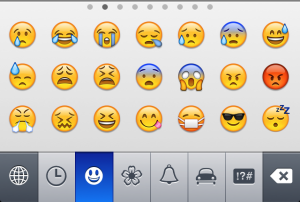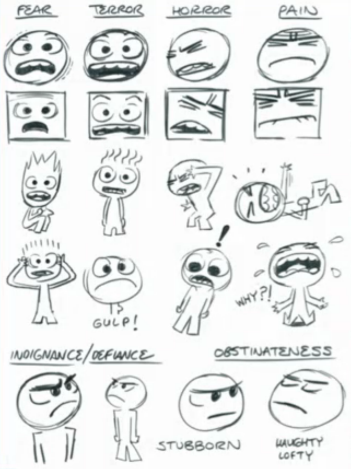Our conversation about Chernoff faces yesterday made me think of emoji (emoticons) and how the visualization of emotion is becoming more important as text-based messaging and interaction grow relative to voice and face-to-face communication. Our faces and voices carry rich emotional information, while our text interactions don’t.
But visualizing emotion is hard. It’s multi-dimensional. And, to me, the somewhat disorderly way companies go about creating emoticons speaks to how hard it is. Popular messaging apps have pages upon pages of emoticons in an attempt to help users add some emotional meat to the cold bones of text.
The iPhone has emoji (you have to enable a special keyboard), and it’s fun to me to think about how Apple designed and ordered them (though they seem primarily designed for a Japanese market).
The first page of emoji shows five faces that you could call happy (or contented) followed by an assortment of faces grouped by feature—winking, hearts, kissing, tongue-sticking-out, etc. Then there’s surprise (unpleasant?), teeth-gritting (I think?), a sad face, another random happy face, and a few other sad faces the meaning of which is hard to infer exactly. The second page has a number of other faces, mostly negative in emotion, along with the all-important face mask emoji:
It’s not a super coherent representation of our various possible emotions, but perhaps it’s “good enough” or suits our culture (or, rather, the Japanese culture) well. What would be a better or more complete representation? Maybe a few icons at least per “basic emotion”? Arranged by intensity? (i.e. neutral smiley to really smiley smiley, or neutral smiley to anxious smiley, or…you get the picture). It’s interesting to ponder.
Facebook is clearly pondering this—check out the new experimental feature that lets you set a mood for your status update. A few Facebook researchers also at a recent public presentation said they worked with an animator at Pixar to experiment with some new emoticons, using Darwin’s emotions as a basis. I thought some of them were fun:
-Galen 😛





http://en.wikipedia.org/wiki/List_of_emoticons
If you go to the wikipedia article on emoticons, you’ll find that there are more eastern emoticons than western. I remember when emoticons were becoming more prevalent I often resorted to eastern emoticons because they were better at expressing what I was trying to convey.
I think the reason why there are more eastern than western emoticons is because eastern cartoons (anime) had a lot more distinct expressions compared to western that could then be translated into emoticons.
The larger and more expressive options then led to greater adoption by western society. Though those that have less exposure to eastern culture would probably be better able to gauge the truth of this comment. I am probably biased because I am part Japanese.
As for using emoticons for a visualization. I think it would still be difficult. If you mean in the context of the Chernoff faces example we saw in class. However if you want to use them where the entire emoticon means one thing (not pieces mean different things) and they are perhaps on a spectrum range of only 4-5 (like colors) it is feasible.
I like your point about anime, I think it probably has had an influence on the design of emoji. To your last paragraph, my post wasn’t about using emoticons for visualization, but rather that emoticons are visualizations of emotion. And it’s interesting to think about which emotions are represented (and which aren’t) and how they’re ordered and displayed. I could imagine a more “scientific” arrangement that started with a row of happy emoticons (from neutral-happy to very happy), followed by a row of sad, then fearful, etc.
But the scientific arrangement doesn’t take into account the design principle of what you use most often should be the easiest to get to (a.k.a. the first page, menu, dropdown, etc.).
That probably more drove the ordering you see in emoticon menus.
I’m sure you’re right that what they thought would be used the most they put toward the front, but from a usability standpoint, there’s no labeling or logical ordering that helps you determine what the face is supposed to mean. Obviously, even the most realistic faces still have some ambiguity. So I wouldn’t call emoticons a “solved” problem.
The feature that Facebook is checking out sounds somewhat similar to the option allowed by Deviantart where you can choose some moods on Journal Posts. I personally love that feature since it helps me go back and evaluate how I was feeling when I wrote a particular post. Adding a similar option to Facebook takes the “How are you feeling” prompt to the next level.
I didn’t know deviantART had that! Super cool!